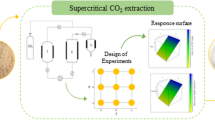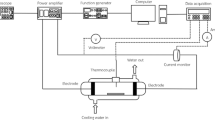Abstract
The extraction of rice bran oil using the conventional organic solvent-based Soxhlet method involves hazardous chemicals, whereas supercritical fluid extraction is a costly high-temperature operating system. The subcritical carbon dioxide Soxhlet (SCDS) system, which operates at a low temperature, was evaluated for the extraction of rice bran oil in this study. In addition, rice bran that had been subjected to steam or hot-air stabilization were compared with unstabilized rice bran (control). The yields; contents of tocopherols, tocotrienols and oryzanol; fatty acid profiles; and the oxidative stabilities of the extracted rice bran oils were analyzed. The yields using hexane and SCDS extraction were approximately 22 and 13–14.5 %, respectively. However, oil extracted using the SCDS system contained approximately 10 times more oryzanol and tocol compounds and had lower free fatty acid levels and peroxide values compared with hexane-extracted oil. Overall, SCDS extraction of steamed rice bran represents a promising method to produce premium-quality rice bran oil.


Similar content being viewed by others
References
Sereewatthanawut I, Prapintip S, Watchiraruji K, Goto M, Sasaki M, Shotipruk A (2008) Extraction of protein and amino acids from deoiled rice bran by subcritical water hydrolysis. Bioresour Technol 99:555–561
Pourali O, Asghari FS, Yoshida H (2009) Sub-critical water treatment of rice bran to produce valuable materials. Food Chem 115:1–7
Patel M, Naik S (2004) Gamma-oryzanol from rice bran oil: a review. J Sci Ind Res India 63:569–578
Goffman F, Pinson S, Bergman C (2003) Genetic diversity for lipid content and fatty acid profile in rice bran. J Am Oil Chem Soc 80:485–490
Chen C-R, Wang L-Y, Wang C-H, Ho W-J, Chang C-MJ (2008) Supercritical carbon dioxide extraction of rice bran oil and column partition fractionation of γ-oryzanols. Sep Purif Technol 61:358–365
Arab F, Alemzadeh I, Maghsoudi V (2011) Determination of antioxidant component and activity of rice bran extract. Scientia Iranica 18:1402–1406
Orthoefer FT (2005) Rice bran oil. In: Shahidi F (ed) Bailey’s industrial oil and fat products. John Wiley, Hoboken
Lakkakula NR, Lima M, Walker T (2004) Rice bran stabilization and rice bran oil extraction using ohmic heating. Bioresour Technol 92:157–161
Amarasinghe BMWPK, Kumarasiri MPM, Gangodavilage NC (2009) Effect of method of stabilization on aqueous extraction of rice bran oil. Food Bioprod Process 87:108–114
Pourali O, Salak Asghari F, Yoshida H (2009) Simultaneous rice bran oil stabilization and extraction using sub-critical water medium. J Food Eng 95:510–516
Thanonkaew A, Wongyai S, McClements DJ, Decker EA (2012) Effect of stabilization of rice bran by domestic heating on mechanical extraction yield, quality, and antioxidant properties of cold-pressed rice bran oil (Oryza sativa L.). LWT Food Sci Technol 48:231–236
Zhang S, Chen R, Wu H, Wang C (2006) Ginsenoside extraction from Panax quinquefolium L. (American ginseng) root by using ultrahigh pressure. J Pharm Biomed Anal 41:57–63
Wang L, Weller CL (2006) Recent advances in extraction of nutraceuticals from plants. Trends Food Sci Technol 17:300–312
Sparks D, Hernandez R, Zappi M, Blackwell D, Fleming T (2006) Extraction of rice brain oil using supercritical carbon dioxide and propane. J Am Oil Chem Soc 83:885–891
Kuk MS, Dowd MK (1998) Supercritical CO2 extraction of rice bran. J Am Oil Chem Soc 75:623–628
Kim H-J, Lee S-B, Park K-A, Hong I-K (1999) Characterization of extraction and separation of rice bran oil rich in EFA using SFE process. Sep Purif Technol 15:1–8
Bruscatto M, Zambiazi R, Sganzerla M, Pestana V, Otero D, Lima R, Paiva F (2009) Degradation of tocopherols in rice bran oil submitted to heating at different temperatures. J Chromatogr Sci 47:762–765
AOCS (2004) Official and tentative methods of the American Oils Chemists’ Society. In: Link WE (ed) American Oil Chemists’ Society. Champaign, IL
I. AOAC (2011) Official methods of analysis. In: AOAC Official Method 972.28: fatty acids (total) in oils and fats (hexane distillation). AOAC International, Maryland, USA, p 13
Zhao S, Zhang D (2014) Supercritical CO2 extraction of eucalyptus leaves oil and comparison with Soxhlet extraction and hydro-distillation methods. Sep Purif Technol 133:443–451
Rukunudin IH, White PJ, Bern CJ, Bailey TB (1998) A modified method for determining free fatty acids from small soybean oil sample sizes. J Am Oil Chem Soc 75:563–568
Crowe T, White P (2001) Adaptation of the AOCS official method for measuring hydroperoxides from small-scale oil samples. J Am Oil Chem Soc 78:1267–1269
Chen MH, Bergman CJ (2005) A rapid procedure for analysing rice bran tocopherol, tocotrienol and γ-oryzanol contents. J Food Compos Anal 18:139–151
Shammugasamy B, Ramakrishnan Y, Manan F, Muhammad K (2014) Rapid reversed-phase chromatographic method for determination of eight vitamin E isomers and γ-oryzanols in rice bran and rice bran oil. Food Anal Methods 1–7
Kim S-M, Chung H-J, Lim S-T (2014) Effect of various heat treatments on rancidity and some bioactive compounds of rice bran. J Cereal Sci 60:243–248
Pradeep PM, Jayadeep A, Guha M, Singh V (2014) Hydrothermal and biotechnological treatments on nutraceutical content and antioxidant activity of rice bran. J Cereal Sci
Kostić MD, Joković NM, Stamenković OS, Rajković KM, Milić PS, Veljković VB (2014) The kinetics and thermodynamics of hempseed oil extraction by n-hexane. Ind Crops Prod 52:679–686
Nasirullah MN, Krishnamurthy KV Nagaraja (1989) Effect of stabilization on the quality characteristics of rice-bran oil. J Am Oil Chem Soc 66:661–663
Choe E, Min DB (2006) Mechanisms and factors for edible oil oxidation. Compr Rev Food Sci Food Saf 5:169–186
Shahidi F, Spurvey SA (1996) Oxidative stability of fresh and heat-processed dark and light muscles of mackerel (Scomber scombrus). J Food Lipids 3:13–25
St. Angelo AJ, Vercellotti J, Jacks T, Legendre M (1996) Lipid oxidation in foods. Crit Rev Food Sci Nutr 36:175–224
F.A.O.U. Nation (2013) The Codex Alimentarius. In: Codex standard for named vegetables oils. World Health Organization, Rome, pp 1–16
Aguilar-Garcia C, Gavino G, Baragaño-Mosqueda M, Hevia P, Gavino VC (2007) Correlation of tocopherol, tocotrienol, γ-oryzanol and total polyphenol content in rice bran with different antioxidant capacity assays. Food Chem 102:1228–1232
Patel M, Naik SN (2004) Gamma-oryzanol from rice bran oil––a review. J Sci Ind Res 63:569–578
Xu Z, Godber JS (1999) Purification and identification of components of γ-oryzanol in rice bran oil. J Agric Food Chem 47:2724–2728
Rong N, Ausman LM, Nicolosi RJ (1997) Oryzanol decreases cholesterol absorption and aortic fatty streaks in hamsters. Lipids 32:303–309
Nakayama S, Manabe A, Suzuki J, Sakamoto K, Inagaki T (1987) Comparative effects of two forms of gamma-oryzanol in different sterol compositions on hyperlipidemia induced by cholesterol diet in rats. Jpn J Pharmacol 44:135–143
Murase Y, Iishima H (1963) Clinical studies of oral administration of gamma-oryzanol on climacteric complaints and its syndrome. Obstet Gynecol Prac 12:147–149
Muhammad N, Luke DA, Shuid AN, Mohamed N, Soelaiman IN (2013) Tocotrienol supplementation in postmenopausal osteoporosis: evidence from a laboratory study. Clinics 68:1338–1343
Sen CK, Khanna S, Roy S (2006) Tocotrienols: vitamin E beyond tocopherols. Life Sci 78:2088–2098
Qureshi AA, Mo H, Packer L, Peterson DM (2000) Isolation and identification of novel tocotrienols from rice bran with hypocholesterolemic, antioxidant, and antitumor properties. J Agric Food Chem 48:3130–3140
Sarmento C, Ferreira S, Hense H (2006) Supercritical fluid extraction (SFE) of rice bran oil to obtain fractions enriched with tocopherols and tocotrienols. Braz J Chem Eng 23:243–249
Azlan A, Ismail M, Abdul Hamid A (2008) Extraction and determination of oryzanol in rice bran of mixed herbarium UKMB: AZ 6807: MR 185, AZ 6808: MR 211, AZ6809: MR 29. ASEAN Food J 15:89–96
Hu W, Wells JH, Shin T-S, Godber JS (1996) Comparison of isopropanol and hexane for extraction of vitamin E and oryzanols from stabilized rice bran. J Am Oil Chem Soc 73:1653–1656
Bergman CJ, Xu Z (2003) Genotype and environment effects on tocopherol, tocotrienol, and γ-oryzanol contents of Southern U.S. rice. Cereal Chem 80:446–449
Pestana V, Zambiazi R, Mendonça CB, Bruscatto M, Lerma-García M, Ramis-Ramos G (2008) Quality changes and tocopherols and γ-oryzanol concentrations in rice bran oil during the refining process. J Am Oil Chem Soc 85:1013–1019
Güçlü Ü, Temelli F (2000) Correlating the solubility behavior of fatty acids, mono-, di-, and triglycerides, and fatty acid esters in supercritical carbon dioxide. Ind Eng Chem Res 39:4756–4766
Jesus SP, Grimaldi R, Hense H (2010) Recovery of γ-oryzanol from rice bran oil byproduct using supercritical fluid extraction. J Supercrit Fluids 55:149–155
Acknowledgments
The authors would like to thank Padi Beras Nasional Berhad (BERNAS) for providing the research funds and the raw materials necessary to complete this study. Additionally, we would like to express our utmost appreciation to the Malaysian Biotechnology Corporation and Supercritical Fluid Center, UPM, for providing the necessary facilities and technical support.
Author information
Authors and Affiliations
Corresponding author
About this article
Cite this article
Chia, S.L., Boo, H.C., Muhamad, K. et al. Effect of Subcritical Carbon Dioxide Extraction and Bran Stabilization Methods on Rice Bran Oil. J Am Oil Chem Soc 92, 393–402 (2015). https://doi.org/10.1007/s11746-015-2596-5
Received:
Revised:
Accepted:
Published:
Issue Date:
DOI: https://doi.org/10.1007/s11746-015-2596-5




